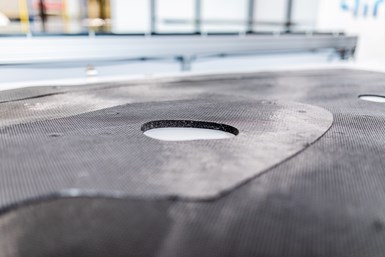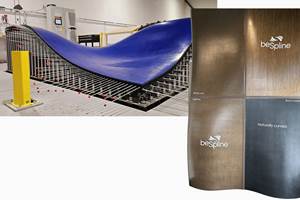Airborne introduces Automated Ply Placement technology at JEC World 2022
Automated, accurate and fully integrated preforming process maximizes design freedom of composite laminates, expands material options.
At the JEC World 2022, Airborne (The Hague, Netherlands) is premiering its Automated Ply Placement technology, which the company says can make multi-material, free-shape and tailored laminates in an automated and user-friendly way compared to other composite automation technologies like automated tape laying or fiber placement (ATL/AFP). The Automated Ply Placement technology enables users to create optimal composite designs and benefit from full automation.
Converting composite material into tailored blank laminates or preforms is a crucial but vulnerable step of making composite parts, Airborne notes. It is either a manual and slow process, or an automated process with limitations in the materials that can be used or the shapes that can be made. Alternately, Airborne’s Automated Ply Placement technology ensures a designer can use all materials available on the market (the process can implement prepreg, dry fiber or thermoplastics), create an optimal, high-accuracy laminate with freeform edges and patches or cut-outs and design for optimal performance.
Unidirectional (UD) tapes, textiles (fabrics, non-crimp fabrics), film, core materials, recycled materials, metal layers and more can be used with this process. Airborne says it is able to handle materials on roll as well as sheet materials. Sandwich laminates are also possible. The system cuts the materials into the right ply shapes, stores it in the buffer station and creates the laminate with robotic ply placement which fully inspects and accurately places plies and spot-welds to stabilize the laminate. Final laminates are reported to be 100% net shape with no trimming required. Moreover, Airborne’s Automated Programming software makes the technology more user friendly; the design, material and operational input is automatically translated to the right machine code and process settings on-the-fly and on the shop floor.
There are multiple benefits to this technology for the user, Airborne says. First is a fully automated and integration layup process on one system (cutting inspection, placement and storage of plies and finished laminates). Secondly, laminate designs can be created that are not feasible, or are difficult to manufacture with other technologies. Third, Airborne has made it so the system is ready to use future materials that are coming to the market, such as recycled materials, bio-based materials or novel material forms that can not be processed with, for example, fiber placement. Since it is a robotic system, the downstream processes such as press/hot-drape forming, trimming, inspection or placement into the mold can also be easily integrated.
“Automated Ply Placement opens up many new possibilities for automation and laminate designs,” Marcus Kremers, CTO of Airborne, emphasizes. “In composites, there are, of course, many materials to choose from and almost all of them come as wide rolls. With other automation technologies, those need to be slit, which is expensive and limits the availability of materials. The ability to automated manufacturing then comes with a limitation in materials and we have aimed to solve that. The system we developed can work with all composite materials to provide the designer maximum freedom.”
Related Content
Broetje-Automation demonstrates rCF placement via AFP
Through the ScrapSeRO project, the system integrator and machine builder successfully processed recycled composites, in addition to more traditional materials, via its highly flexible Staxx One system.
Read MoreASCEND program update: Designing next-gen, high-rate auto and aerospace composites
GKN Aerospace, McLaren Automotive and U.K.-based partners share goals and progress aiming at high-rate, Industry 4.0-enabled, sustainable materials and processes.
Read MorePlant tour: BeSpline/Addcomp, Sherbrooke, QC, Canada
Composites automation specialist increases access to next-gen technologies, including novel AFP systems and unique 3D parts using adaptive molds.
Read MoreMcClarin Composites partners with ExxonMobil to accelerate high-speed RTM
Multimillion-dollar investment to drive next-gen automated RTM technology will open new applications and markets for composites OEMs.
Read MoreRead Next
All-recycled, needle-punched nonwoven CFRP slashes carbon footprint of Formula 2 seat
Dallara and Tenowo collaborate to produce a race-ready Formula 2 seat using recycled carbon fiber, reducing CO2 emissions by 97.5% compared to virgin materials.
Read More“Structured air” TPS safeguards composite structures
Powered by an 85% air/15% pure polyimide aerogel, Blueshift’s novel material system protects structures during transient thermal events from -200°C to beyond 2400°C for rockets, battery boxes and more.
Read MoreDeveloping bonded composite repair for ships, offshore units
Bureau Veritas and industry partners issue guidelines and pave the way for certification via StrengthBond Offshore project.
Read More


























